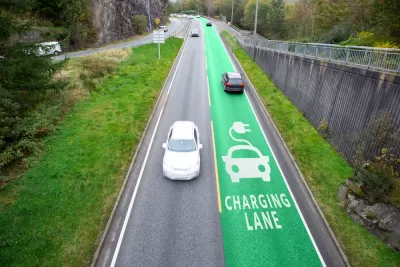The future of road infrastructure likely includes wireless electric charging, innovative construction materials, and more data collection. Will cities remember to prioritize pedestrian safety, too?

As technology becomes more and more embedded in transportation, Skip Descant, writing in Governing, investigates how road infrastructure might change to accommodate new technologies. With more vehicles requiring electric charging, “Converged and coordinated sectors like energy and transportation are the prerequisite to effectively growing the widescale adoption of EVs, experts say.”
According to Allie Kelly, executive director of The Ray, a ‘technology testbed’ in Georgia, “We can’t support electrified transportation without building at-scale EV charging hubs. And we can’t support functionality like platooning or functionality like Level 5 autonomy without building the digital and the physical infrastructure to support more connectivity, and to leverage data and transportation with connected and autonomous vehicles.”
To prepare for the future of transportation, “Energy, transportation and charging hubs are coming together in the form of initiatives like using roadway rights of way for the installation of solar fields to generate electric power.” Descant adds that some cities and states are experimenting with new road building materials, such as recycled car tires.
There are challenges on the regulatory side,too. Urban Movement Labs, a Los Angeles-based nonprofit transportation and urbanism think tank, “is working to develop an ‘integration manual’ to help cities understand the regulatory landscape, and other concerns, for systems like these.”
As the article points out, new technologies, such as delivery drones and robots and autonomous vehicles, are already proliferating. Meanwhile, pedestrian death rates keep growing. “For everything else we do, safety’s got to be an imperative. And we use this moment to advance safety,” said Mark Rosekind, former administrator with the National Highway Traffic Safety Administration (NHTSA) and chief safety innovation officer at mobility-as-a-service (MaaS) company Zoox. But while technology makes lofty promises for speed and efficiency, cities continue to lag behind on low-tech improvements that could reduce traffic deaths and limit the impact of human—and, in the future, autonomous vehicle—error behind the wheel.
FULL STORY: How Will Road Infrastructure Change In The Next 30 Years?

Alabama: Trump Terminates Settlements for Black Communities Harmed By Raw Sewage
Trump deemed the landmark civil rights agreement “illegal DEI and environmental justice policy.”

Study: Maui’s Plan to Convert Vacation Rentals to Long-Term Housing Could Cause Nearly $1 Billion Economic Loss
The plan would reduce visitor accommodation by 25% resulting in 1,900 jobs lost.

Why Should We Subsidize Public Transportation?
Many public transit agencies face financial stress due to rising costs, declining fare revenue, and declining subsidies. Transit advocates must provide a strong business case for increasing public transit funding.

Wind Energy on the Rise Despite Federal Policy Reversal
The Trump administration is revoking federal support for renewable energy, but demand for new projects continues unabated.

Passengers Flock to Caltrain After Electrification
The new electric trains are running faster and more reliably, leading to strong ridership growth on the Bay Area rail system.

Texas Churches Rally Behind ‘Yes in God’s Back Yard’ Legislation
Religious leaders want the state to reduce zoning regulations to streamline leasing church-owned land to housing developers.
Urban Design for Planners 1: Software Tools
This six-course series explores essential urban design concepts using open source software and equips planners with the tools they need to participate fully in the urban design process.
Planning for Universal Design
Learn the tools for implementing Universal Design in planning regulations.
Caltrans
Smith Gee Studio
Institute for Housing and Urban Development Studies (IHS)
City of Grandview
Harvard GSD Executive Education
Toledo-Lucas County Plan Commissions
Salt Lake City
NYU Wagner Graduate School of Public Service





























